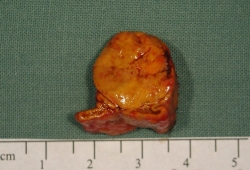Summary
Definition
ანამნეზი და გასინჯვა
ძირითადი დიაგნოსტიკური ფაქტორები
- hypertension
სხვა დიაგნოსტიკური ფაქტორები
- age 20 to 70 years
- nocturia, polyuria
- lethargy
- mood disturbance (irritability, anxiety, depression)
- difficulty concentrating
- paresthesias, muscle cramps
- muscle weakness
- palpitations
რისკფაქტორები
- family history of PA
- family history of early onset of hypertension and/or stroke
დიაგნოსტიკური კვლევები
1-ად შესაკვეთი გამოკვლევები
- plasma potassium
- aldosterone/renin ratio
გასათვალისწინებელი კვლევები
- oral salt loading test
- saline infusion testing
- genetic testing
- adrenal CT
- adrenal venous sampling
- adrenal MRI
- posture stimulation testing
- angiotensin II infusion testing
- 24-hour urinary hybrid steroids (18-hydroxy- and 18-oxo-cortisol)
- dexamethasone suppression testing
ახალი ტესტები
- ¹¹ C-Metomidate PET/CT
მკურნალობის ალგორითმი
unilateral PA
bilateral PA (excluding familial hyperaldosteronism type I)
familial hyperaldosteronism type I
კონტრიბუტორები
ავტორები
Michael Stowasser, MBBS, FRACP, PhD

Professor
Endocrine Hypertension Research Centre
University of Queensland Frazer Institute
Greenslopes and Princess Alexandra Hospitals
Brisbane
Queensland
Australia
გაფრთხილება:
MS is an author of several references cited in this topic.
მადლიერება
Professor Michael Stowasser would like to gratefully acknowledge Professor Richard D. Gordon, a previous contributor to this topic.
რეცენზენტები
Paolo Mulatero, MD
Department of Medicine and Experimental Oncology
Division of Medicine and Hypertension
San Giovanni Battista Hospital
Torino
Italy
გაფრთხილება:
PM declares that he has no competing interests.
Wail Malaty, MD
Clinical Professor
Department of Family Medicine
University of North Carolina
Chapel Hill
Assistant Program Director
MAHEC Rural Family Medicine Residency
Hendersonville
NC
გაფრთხილება:
WM declares that he has no competing interests.
რეცენზენტების განცხადებები
BMJ Best Practice-ის თემების განახლება სხვადასხვა პერიოდულობით ხდება მტკიცებულებებისა და რეკომენდაციების განვითარების შესაბამისად. ქვემოთ ჩამოთვლილმა რეცენზენტებმა თემის არსებობის მანძილზე კონტენტს ერთხელ მაინც გადახედეს.
გაფრთხილება
რეცენზენტების აფილიაციები და გაფრთხილებები მოცემულია გადახედვის მომენტისთვის.
წყაროები
ძირითადი სტატიები
Mulatero P, Sechi LA, Williams TA, et al. Subtype diagnosis, treatment, complications and outcomes of primary aldosteronism and future direction of research: a position statement and consensus of the Working Group on Endocrine Hypertension of the European Society of Hypertension. J Hypertens. 2020 Oct;38(10):1929-36. აბსტრაქტი
Reincke M, Bancos I, Mulatero P, et al. Diagnosis and treatment of primary aldosteronism. Lancet Diabetes Endocrinol. 2021 Dec;9(12):876-92. აბსტრაქტი
Funder JW, Carey RM, Mantero F, et al. The management of primary aldosteronism: case detection, diagnosis, and treatment. J Clin Endocrinol Metab. 2016 May;101(5):1889-916.სრული ტექსტი აბსტრაქტი
Young WF Jr. Diagnosis and treatment of primary aldosteronism: practical clinical perspectives. J Intern Med. 2019 Feb;285(2):126-48.სრული ტექსტი აბსტრაქტი
გამოყენებული სტატიები
ამ თემაში მოხსენიებული წყაროების სრული სია ხელმისაწვდომია მომხმარებლებისთვის, რომლებსაც აქვთ წვდომა BMJ Best Practice-ის ყველა ნაწილზე.

დიფერენციული დიაგნოზები
- Essential hypertension (HTN)
- Thiazide-induced hypokalemia in patient with essential HTN
- Renal artery stenosis
მეტი დიფერენციული დიაგნოზებიგაიდლაინები
- NCCN clinical practice guidelines in oncology: neuroendocrine and adrenal tumors
- Japan Endocrine Society clinical practice guideline for the diagnosis and management of primary aldosteronism 2021
მეტი გაიდლაინებიშედით სისტემაში ან გამოიწერეთ BMJ Best Practice
ამ მასალის გამოყენება ექვემდებარება ჩვენს განცხადებას